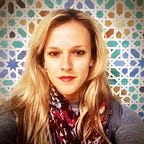What We Can’t Unsee
Last month I had the pleasure to write an opening essay for Shira Inbar’s bilingual zine SEPARATED/SEPARADOS, dedicated to the migrant children separated from their parents and detained at the Southern U.S. border. The whole publication is printed in contrasting orange and blue colors, and is comprised of beautiful and moving artwork created by 31 graphic designers. Proceeds from the zine go towards legal assistance and psychosocial support for children in the transit centers at the border.
This summer, two exhibits featured my favorite artist and framed his work in an entirely new light for me. It’s rare that a show can move us so much that we can’t look at the works in the same way again. The first one, titled “Rothko in Lampedusa,” was curated by UNHCR this year at the Venice Biennale. The exhibit features art from six refugees, as well as pieces from art world giants like Ai Weiwei and Nalini Malani. The exhibit explores the work of Mark Rothko, who himself fled Russia for the US as a child.
The Metropolitan Museum in New York held the second exhibit — or what could better be interpreted as a campaign, or even an act of protest against an administration so hostile to refugees. On June 20th, in honor of World Refugee Day, the museum covered works by artists including Rothko, Ibrahim El-Salahi, Piet Mondrian, Sopheap Pich, and Marc Chagall under a gray shroud. Each object was accompanied by a bright yellow sign that read, “This work was created by a refugee.”
I had loved these paintings for so long, and knew the stories behind them. Yet I never thought of Rothko or Chagall as refugees before, and for me this added an entirely new kind of resonance with their works. In Chagall’s “The Lovers,” where I once saw longing, I now only see displacement. In Rothko’s paintings, where I once saw contrast, I now see separation.
It is only through art that can we truly understand the absurdity and horror of war and displacement — because these are things that elude reason entirely. Despite the efforts of this administration and their supporters, it is similarly impossible to justify a policy of separating children from their parents at the border, when cruelty is the only reasoning behind it. It doesn’t make sense on paper, and it never will.
The family separation policy was presented last year as a “zero tolerance” approach intended to deter migration and inhibit asylum seekers from Central America. As a result of this policy, thousands of children have been separated from their parents and placed in squalid living conditions. There have been reports of physical and sexual abuse in Customs and Border Control detention centers. Children have died in ICE custody, and hundreds are missing because the policy didn’t include measures to trace and reunite the children with their families.
While the policy officially ended in June 2018 with an executive order, hundreds of children have been separated from their parents in a system seemingly accountable to no one. The devastation and trauma of this ongoing crisis is causing permanent damage to young children and their families.
The entire policy is based on the idea that word of such unspeakable cruelties at the border would reach all parts of Central America soon enough to deter people from fleeing to the United States. Unsurprisingly, border arrest data has shown that families have continued to arrive at roughly the same rates a year after the policy was implemented. Leaving one’s home to flee to safety, especially with small children, is not an easy decision to make for anyone, especially in light of the threat of separation and cruelty at the US border. No one would risk losing their children unless staying at home is more dangerous.
Asylum seekers and refugees are among the most vulnerable people in the world. There are few legal mechanisms available that uphold their rights. This leaves them vulnerable to abuse by authorities and smugglers alike. This is why it’s incumbent on us to lend our voices to the voiceless. We can do this by supporting initiatives like this one, while demanding accountability of our elected officials: to end this policy permanently, reform the asylum process, and create transparent protection mechanisms for the world’s most vulnerable.
Of their World Refugee Day campaign, The Met stated, “It’s not being party-political, but it is about taking a responsibility to address social injustice.”
Each of us must take on that responsibility, too. Because our rights depend on their rights. Our freedoms depend on their freedoms.
You can find the entire collection here, all proceeds go to Save The Children: https://separated.site/
